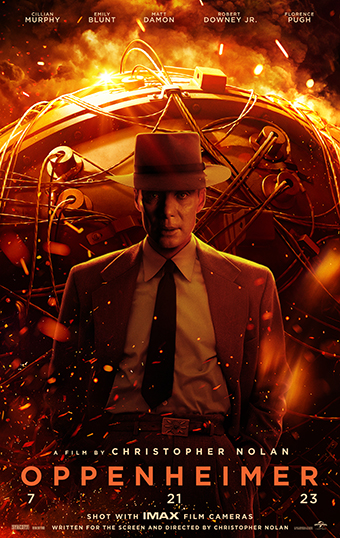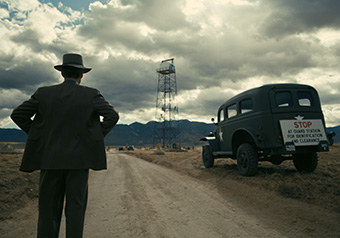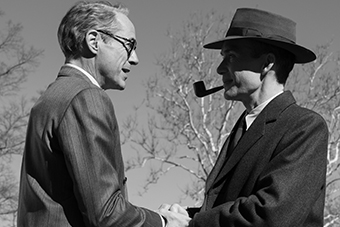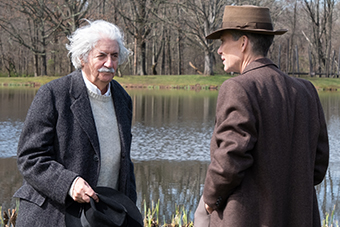Movies

New Releases • A-D • E-H • I-P • Q-Z • Articles • Festivals • Interviews • Dark Knight • Indiana Jones • MCU
Go behind the scenes of Oppenheimer with the cast and crew, including star Cillian Murphy and director Christopher Nolan
Featurette: Universal Pictures
Oppenheimer
Directed by Christopher Nolan
Rated R
Detonated 21 July 2023
#Oppenheimer • #IMAX • #70mm
Leave it to Christopher Nolan to take something as complicated as quantum mechanics and the true story behind the creation of the atomic bomb and create a milestone, nail-biting movie event that needs to be seen on the biggest screen possible.
How to Dismantle Build an Atomic Bomb
Tick… tick… tick…
It’s the classic ticking time bomb plot device from action movies. The fate of the free world is at stake in the face of a megalomaniacal threat. But this time, it’s not about dismantling the bomb, it’s about making the bomb on time. Then there’s the stress of a detonation that might set the entire world on fire, followed by the political aftermath in a country roiled by McCarthyism and paranoia.

The atomic bomb test conducted at Alamogordo, 250 miles south of Los Alamos, New Mexico, in July 1945, followed by Pres. Truman’s (off-screen) deployment of the atomic bomb on Hiroshima and Nagasaki in August 1945 isn’t the movie’s climax. What’s astonishing about Oppenheimer is the movie doesn’t lose any momentum after the drop event. There’s another entire act that follows it, which turns into an incredibly entertaining drama involving politics and paranoia.
While J. Robert Oppenheimer (Cillian Murphy) goes under the microscope during a post-detonation investigation, with his security clearance — and career — hanging in the balance, his sometime-ally Admiral Lewis Strauss (Robert Downey Jr.) sits before a committee determining if he’s worthy of becoming commerce secretary after having served four years as chairman of the Atomic Energy Commission.
In the end, nobody wins. Not the man. Not the nation. Not the world.
And, as usual, Nolan leaves audiences with the mind racing.
Who is more paranoid in this case? A true genius, politicians — and all their Machiavellian ways of dominance and self-interest — or the people who empowered them?
While Nolan’s screenplay is based on the Pulitzer Prize-winning biography American Prometheus: The Triumph and Tragedy of J. Robert Oppenheimer by Kai Bird and Martin J. Sherwin, this is in no way a standard cradle-to-grave bio-pic. This is a character study of a man, a nation and a world. All of them altered by this historic series of events.
Trinity
There are many ways to deconstruct this movie and break down what makes it great. Oppenheimer named his atomic bomb test Trinity, after the Holy Trinity of the Father, the Son and the Holy Ghost. Here, there are also three facets to consider: the cast, the screenplay and the filming.

J. Robert Oppenheimer (Cillian Murphy) assesses the Trinity tower
Start with the cast and the people they’re portraying, while keeping in mind this line from the movie: “It might not be your fault, but it’s your problem.”
Cillian Murphy — a longtime Nolan favorite with appearances in all three Dark Knight movies as well as Inception and Dunkirk — digs into Oppenheimer and plays a man who’s self-labeled as neurotic, egotistical, womanizing and unstable. He’s also a suspected communist. He’s the protagonist. He’s the “good guy.” He knows he’s flawed, but even his own genius can’t find a way to become a different, better person.
Robert Downey Jr. — appreciated by many for his take on Tony Stark, the playboy genius who created Iron Man while held captive in a cave — is Admiral Lewis Strauss. Maybe it’s unfair to label him as the antagonist in the complicated context of Oppenheimer’s life, but he most certainly is at least a part-time adversary. He also has an ego that might well make even Stark blush.
There isn’t a weak spot in this stunning cast which also features a couple remarkably impactful and equally complicated women, Kitty Oppenheimer (Emily Blunt), Robert’s patient – but strong-willed – wife and Jean Tatlock (Florence Pugh), a lover who’s somewhat co-dependent.
Others include Matt Damon (Lt. General Leslie Groves), Jason Clarke (Roger Robb) and Kenneth Branagh (Niels Bohr). Oppenheimer also puts a fresh light on talent that deserves another look, including Alden Ehrenreich, Dane DeHaan and Josh Hartnett.
But there are also a couple remarkable performances by Tom Conti (as Albert Einstein) and Gary Oldman (as Pres. Harry Truman), both of whom are unrecognizable in their relatively small roles — roles that could have so easily turned into caricatures. The parts are small, but like atoms, they’re also significant to the movie’s composition.
Einstein dances around the idea that maybe he walked away from the “new physics” and quantum mechanics, driven by a fear of where it all may lead. Truman, at least in the conversation of the movie, requests the “cry baby” that is Oppenheimer never be allowed back into the White House after Oppenheimer shares the twist in his soul over having enabled the world’s destruction.
The conversations between Oppenheimer, Einstein and Truman are certainly only a small piece in this three-hour epic, but they are tremendously impactful.
The Gadget
Okay. Great cast. Then there’s the filming.
Think about the Manhattan Project. It employed 4,000 people over three years at a cost of $2 billion. The isolated atomic bomb test detonation in New Mexico anticipated creating a pillar of fire 10,000 feet tall with a one-mile radius of destruction. In Japan, the two bomb-drops (Little Boy and Fat Man) and their after-effects killed an estimated 220,000 people. And the project was run by a man — Oppenheimer — who himself acknowledged he couldn’t run a hamburger stand.

Lewis Strauss (Robert Downey Jr.) with Oppenheimer (Cillian Murphy)
Telling that story here is a feat of filmmaking artistry. Nolan continues to shun digital photography (and the moviegoing world should applaud that stance). Instead, Oppenheimer was shot and finished on film. But not just any film. Much of it was filmed using the extra-large IMAX format. And even then, not all of that was “standard” IMAX film stock. In making Oppenheimer, Nolan, cinematographer Hoyte Van Hoytema and IMAX collaborated to create a wholly new black-and-white IMAX film stock. The alternating use of color and black-and-white serves as a device to distinguish between time periods as the story unfolds in a non-linear fashion.
But then double-down. Nolan prefers to take things even further by filming as much as possible on-set (even better: on location), including visual effects, rather than relying on digital post-production enhancements.
Throw in an atmospheric score from Ludwig Göransson and remarkable sound design and the results are breathtaking. The Trinity test itself is a jaw-dropping display of filmmaking prowess and thoughtfulness around the experience being shared both within the story and by the audience. Consider how silence plays a role in the presentation. Silence accompanied only by the sound of a human breathing. Oppenheimer breathing.
Whether the theatrical presentation is 70mm film or IMAX film (even IMAX digital), the effort and the expense to see Oppenheimer in a “premium” theatre are rewarded with a movie experience that cannot be replicated at home. Even at a really big home.
A Beautiful Mind
So how do you adapt a Pulitzer-winning biography and distill it into a meaningful movie experience? You start by acknowledging you’re not going to even attempt to boil the ocean. Just boil the frog.
As Jean Tatlock tells J. Robert Oppenheimer, “It’s not about the book. It’s about the ideas.”

Albert Einstein (Tom Conti) with Oppenheimer (Cillian Murphy)
Nolan’s screenplay is itself a work of precision. The dialogue serves to cast light on the characters even as the cast and the action illuminate the screen. For example, a facet of Oppenheimer’s genius is referenced in a conversation; since he wanted a personal challenge, he learned enough Dutch in the space of six weeks so he could teach quantum mechanics to a Dutch class. But, at the same time, he disdains mathematics and lab work; in another scene, he’s seen accidentally breaking beakers and being left behind while the rest of the class is allowed to attend a lecture by Niels Bohr.
Particularly with Inception and Tenet, Nolan has proven an adeptness at telling rich, multi-layered stories, continuously shuffling and defining those layers while propelling the main narrative forward. Oppenheimer’s story is perfectly suited to that approach.
As a man of both conviction and contradiction, Oppenheimer’s character and the world he lives in are revealed as Nolan starts to shift those layers. There are the scientists and the politicians. There are the dangers from Nazis and communism; the geopolitical events of a war-torn world. Then, through what should be bland storytelling — people sitting at tables and in front of committees — greater consequences and implications are revealed.
Nolan latches onto a great way to end the story. It’s an eerie conclusion focused on paranoia and politics. Strauss exhibits his own paranoia and asserts people are talking about him; Oppenheimer is belittling him and Einstein is ignoring him.
But the truth is even more demeaning. Nobody’s talking about Strauss at all because he’s inconsequential. They’re talking about something much more significant: the dangers of where science might go next.
Thinking about contemporary life and the threats surrounding artificial intelligence, those words from earlier in the movie become a theme that haunts far beyond the end credits.
It might not be your fault. But now it’s your problem.
1 August 2023 – Oppenheimer: Take Three (IMAX)
Here’s some clarification around the logic behind the black-and-white and color film scenes. It’s not strictly a chronological consideration, such as pre-Trinity (color) and post-Trinity (black-and-white).
It’s more interesting. Color signifies the first-person, from the point of view of J. Robert Oppenheimer. That’s also when he’s primarily exerting influence.
Black-and-white represents the third-person action. While not a strict rule, this is also when Oppenheimer is being disempowered or otherwise judged.
There is one key scene which switches between both color and black-and-white, quite possibly indicating a power shift as forces start to work against Oppenheimer.
Here’s a cool article about Nolan writing the screenplay in first-person on The Script Lab.
• A slightly edited version was originally published at MovieHabit.com.




